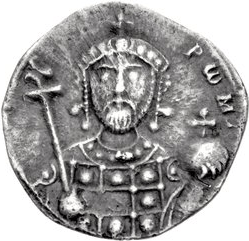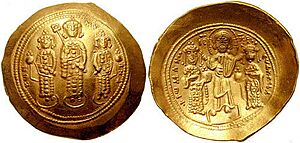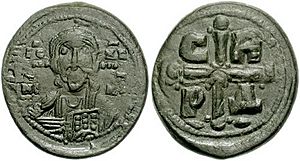Romanos IV Diogenes facts for kids
Quick facts for kids Romanos IV Diogenes |
|
|---|---|
| Emperor and Autocrat of the Romans | |

A silver miliaresion of Romanos IV Diogenes
|
|
| Byzantine emperor | |
| Reign | 1 January 1068 – 1 October 1071 |
| Coronation | 1 January 1068 |
| Predecessor | Constantine X |
| Successor | Michael VII |
| Born | c.1030 Cappadocia |
| Died | 1072 (aged 42) Prote (modern-day Kınalıada, İstanbul, Turkey) |
| Spouse | Alusiana Eudokia Makrembolitissa |
| Issue | Constantine Diogenes Nikephoros Diogenes Leo Diogenes |
| House | Diogenoi |
| Father | Constantine Diogenes |
| Mother | Argyrosa |
Romanos IV Diogenes (Greek: Ρωμανός Διογένης) was a brave Byzantine general. He became Byzantine Emperor after marrying the empress Eudokia Makrembolitissa. He ruled from 1068 to 1071. During his rule, he wanted to make the Byzantine army strong again. He also aimed to stop Turkish attacks on the empire. In 1071, he was captured by Alp Arslan at the Battle of Manzikert. His army was defeated there.
While he was still a prisoner, some people from the Doukas family took over the government. When Romanos was set free, he was defeated and held captive again. In 1072, he was blinded and sent to a monastery. He died soon after from his injuries.
Contents
Becoming Emperor
Romanos Diogenes came from a powerful Greek family in Cappadocia. His father was Constantine Diogenes. Romanos was known for being brave and generous. He was also a bit impulsive. He became a skilled general in the army. He served in places like Syria and along the Danube River. In 1067, he was accused of trying to take the throne from the sons of Constantine X Doukas.
While waiting for his punishment, the empress Eudokia Makrembolitissa called him to her. She told him she had forgiven him. She also chose him to be her husband and the new emperor. She wanted a strong husband to protect her and her sons. She also liked Romanos very much. Most people agreed with her choice. This was because the Seljuk Turks had taken over much of Cappadocia. They had even captured the important city of Caesarea. The army needed a strong leader.
Empress Eudokia had promised her late husband, Constantine X, that she would not remarry. But the Patriarch of Constantinople, John Xiphilinos, allowed her to break this promise. The senate also approved. So, on January 1, 1068, Romanos married the empress. He was then crowned Emperor of the Romans.
Romanos's Qualities
Empress Eudokia was very fond of Romanos. People said he was handsome and had many good qualities. However, he could be very strict and harsh. He once ordered a soldier's nose to be cut off for stealing a donkey. He loved fighting his enemies. He was very brave and often went into battle without weapons or guards. This worried his generals. He also didn't care much about the risks he took.
Romanos started to feel that Empress Eudokia was trying to control him. He grew less respectful of her.
Fighting the Turks

Romanos IV was now the main emperor. He was also the guardian of his stepsons, Michael VII, Konstantios, and Andronikos Doukas. But his new power upset the Doukas family. Especially John Doukas, who was a powerful official. The Varangian Guard also didn't like the marriage. Romanos decided the best way to show his power was to lead the army himself. He wanted to focus the government on the war against the Turks.
By 1067, the Turks were attacking many parts of the empire. They had even sacked Caesarea and its church. Romanos believed the Byzantine army was better than the Turks. He saw the Turks as just groups of robbers. But he didn't realize how weak the Byzantine army had become. His predecessors, especially Constantine X Doukas, had neglected it. His army was made up of soldiers from different places. They were not well-trained or organized. Romanos did not spend time improving their weapons or fighting methods. He was a good general, but his quick temper was a problem.
1068 Campaign
Romanos's first military actions were somewhat successful. This made him more confident. Antioch was being attacked by Saracens from Aleppo and Turkish troops. Romanos marched to the southeastern border to stop them. On his way, he heard that a Seljuk army had attacked Pontus. They had plundered Neocaesarea. He quickly took a small group of soldiers and chased them. He forced them to leave their stolen goods and prisoners. However, many Turkish soldiers got away.
Romanos then rejoined his main army. They marched through the mountains to invade the Emirate of Aleppo. Romanos captured Hierapolis. He made it stronger to protect the empire's southeastern areas. He fought more battles against the Saracens, but neither side won completely. As the fighting season ended, Romanos went back north. He heard about another Turkish raid in Asia Minor. They had sacked Amorium. But they returned to their base too fast for Romanos to catch them. He arrived back in Constantinople by January 1069.
1069 Campaign
Plans for the next year's fighting were disrupted by a rebellion. One of Romanos's Norman soldiers, Robert Crispin, led some Frankish troops. They started stealing from the countryside near Edessa. They also attacked tax collectors. Crispin was captured and sent away. But the Franks continued to cause trouble for a while. Meanwhile, the Turks attacked the area around Caesarea again. Romanos had to spend time driving them out of Cappadocia. He was eager to start his main campaign. He even ordered all prisoners to be executed, including a Turkish leader who offered a huge payment for his life.
After bringing some peace to the area, Romanos marched towards the Euphrates River. He crossed the river at Romanopolis. He hoped to capture Akhlat near Lake Van. This would protect the Armenian border. Romanos led a large group of soldiers towards Akhlat. He left most of his army to defend the Mesopotamian border. But this part of the army was defeated by the Turks. The Turks then sacked Iconium. This forced Romanos to change his plans and return to Sebaste. He ordered the commander of Antioch to secure the mountain passes. He tried to catch the Turks at Heracleia. The Turks were trapped in the mountains of Cilicia. But they managed to escape to Aleppo, leaving their stolen goods behind. Romanos returned to Constantinople again, without the big victory he wanted.
Events in Constantinople
In 1070, Romanos stayed in Constantinople. He had to deal with many government issues. One big problem was the fall of Bari to the Normans. They had been attacking it since 1068. Romanos sent a fleet with supplies and soldiers. But a Norman group defeated the fleet. So, the last Byzantine outpost in Italy surrendered on April 15, 1071.
Romanos also made some changes at home that people didn't like. He cut down on unnecessary spending at court. He reduced the salaries of many nobles. He also lowered the profits of tradesmen. His focus on the army made him unpopular with governors and military leaders. He wanted to stop them from misusing their power. He also made the mercenaries follow stricter rules, which they disliked. The common people also didn't like Romanos. He didn't entertain them with games. He also didn't help the peasants in the countryside. All this made it easier for his enemies to act against him later.
Still, Romanos did not forget about the Turks. Since he couldn't lead the army himself, he gave command to Manuel Komnenos. Manuel was the nephew of a former emperor. He fought the Turks but was captured by a Turkish general named Khroudj. Manuel convinced Khroudj to meet Romanos in Constantinople. They made an alliance. This made the Seljuk Sultan Alp Arslan angry. He attacked the Byzantine Empire. He captured the important fortresses of Manzikert and Archesh. Romanos offered to trade Manzikert and Archesh for Hieropolis in Syria. Romanos had captured Hieropolis three years earlier.
Battle of Manzikert

In the spring of 1071, Romanos marched with a large army to take back Manzikert. He was also talking with Alp Arslan about a peace deal. It was clear the army had discipline problems. Soldiers often stole from areas near their camps. When Romanos tried to make them follow stricter rules, a group of German soldiers rebelled. The emperor had a very hard time controlling them.
Romanos thought Alp Arslan was far from Manzikert. So, he split his army. He sent one part to attack Akhlat, which the Turks held. Romanos went with the main army to Manzikert and quickly recaptured it. Then, his advance group met the Seljuk army, which was coming fast towards Manzikert. Romanos ordered the forces attacking Akhlat to rejoin the main army. But they ran into another large Turkish army and had to retreat. Romanos's army was already smaller. Then, his Uzes soldiers left and joined the Turks.
Alp Arslan did not want to fight the Byzantine army. He offered a peace treaty with good terms for Romanos. But Romanos wanted a big military victory. He refused the offer. Both armies got ready for battle on August 26, 1071. The battle lasted all day. Neither side gained a clear advantage. Then, the emperor ordered part of his army to return to camp. But the right side of the army misunderstood the order. Andronikos Doukas, who led the reserves, used this confusion to betray Romanos. He claimed Romanos was dead. He marched away from the battle with about 30,000 men. He was supposed to protect the emperor's retreat. The Turks then started to push hard against the Byzantine army.
When Romanos found out what happened, he tried to fix the situation. He fought bravely even after his horse was killed. He killed many enemies. But he got a hand wound that stopped him from using his sword. He was soon captured.
Some historians say Alp Arslan at first didn't believe the dirty, tired warrior was the Roman Emperor. Romanos and Arslan never expected to meet like this. Alp Arslan then stepped down and put his foot on Romanos's neck. This was a sign of humiliation. But after this, Arslan helped Romanos up. He ordered that Romanos be treated like a king. He was very kind to Romanos during his eight days in the camp. He then released the Emperor. In return, Romanos promised a treaty and a large payment. Alp Arslan first asked for 10 million nomismata (coins). But he later lowered it to 1.5 million, plus 360,000 annually.
Some Muslim sources say Alp Arslan treated Romanos harshly. He reportedly said Romanos was "too trivial" to kill. He also hit Romanos and kicked him. He put him in chains and pulled his hair. He told Romanos that his troops were "food for the Muslims."
Alp Arslan asked Romanos what he would do if Romanos was the captor. Romanos honestly said, "the worst!" This answer impressed Alp Arslan. He said, "He has spoken the truth! This is an intelligent, tough man. He should not be killed." After agreeing on the payment, Alp Arslan sent Emperor Romanos back to Constantinople. A Turkish escort carried a banner above him that read: "There is no god but Allah and Muhammad is his messenger."
Betrayal and End
Meanwhile, the group against Romanos IV decided to use the situation. Michael VII was declared the only ruler on October 1, 1071. Romanos was removed from power. A month later, John Doukas and Michael Psellos forced Eudokia to go to a monastery. They then refused to keep the agreement made between Arslan and Romanos. Romanos soon returned. He and the Doukas family gathered troops. A battle was fought between Constantine, Andronikos Doukas, and Romanos. Romanos was defeated. He went to the fortress of Tyropoion, and then to Adana in Cilicia. Andronikos chased him. Romanos was forced to surrender by the soldiers at Adana. They promised him safety. Before leaving the fortress, he gathered all the money he had. He sent it to the Sultan as proof of his good faith. He sent a message saying he was sending all he had as thanks.
Andronikos said Romanos's life would be spared if he gave up being emperor and went to a monastery. Romanos agreed. This agreement was approved in Constantinople. However, John Doukas broke the agreement. He sent men to ambush and blind Romanos on June 29, 1072, in Kotyaion. Romanos was led away, asking for mercy. He was then sent away to Prote in the Sea of Marmara. Without medical help, his wound became infected. He died a slow, painful death. A few days before he died, Romanos received a letter from Michael Psellos. It congratulated him on losing his eyes. He finally died, praying for his sins to be forgiven. His widow Eudokia was allowed to give him a grand funeral. Historian John Julius Norwich wrote that his enemies "martyred a courageous and upright man."
Family
Romanos IV Diogenes had at least one son with his first wife, a daughter of Alusian of Bulgaria:
- Constantine Diogenes: He married Theodora, sister of Alexios I Komnenos. This marriage was arranged after Romanos IV died. But it didn't last long. Constantine died in 1073 while fighting near Antioch.
With his second wife, Empress Eudokia Makrembolitissa, he had:
- Leo Diogenes: Born in 1069. He was made co-emperor during his father's rule. Later, under Emperor Alexius I, he was given important commands. He died in 1087 during Alexius's campaigns.
- Nikephoros Diogenes: Born in 1070. He was made co-emperor when he was born.
See also
 In Spanish: Romano IV Diógenes para niños
In Spanish: Romano IV Diógenes para niños


